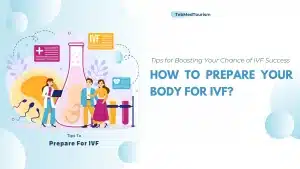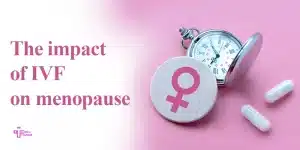Many couples consider the IVF success rate in 2025 when considering using reproductive therapy to start a family. The process of in vitro fertilization, or IVF, has undergone significant improvements over time. The likelihood of success is higher in 2025 than it was previously.
Individual results, however, can vary based on several variables, including age, health, and lifestyle. Understanding the variables that affect the success rate of IVF and how to improve your chances is therefore crucial.
Although it can be hard to identify the top countries in 2025 for IVF successful rate without accurate statistics, countries like Spain, Greece, the Czech Republic, Iran, and Latvia are some of the countries with high standards of customized fertility treatments and modern facilities. IVF success rate is typically greater in countries with strong legislation, skilled professionals, and access to advanced technologies.
What is IVF?
In-vitro fertilization, or IVF, is a fertility procedure. Couples who are struggling to conceive benefit from it. The sperm and egg are combined outside the body in a lab to produce an embryo. After a few days of growth, the embryo is taken into the woman’s uterus, where it can develop into a baby.
IVF is a fertility treatment that involves fertilizing sperm and eggs in a lab setting outside of the body. The resulting embryo (or embryos) is then transported to the uterus for implantation and possible pregnancy. Infertility is frequently overcome by individuals and couples using this procedure, which is also referred to as assisted reproductive technology.
IVF Process
- Before beginning treatment, your doctor should review your options with you and guide you through each of the following steps:
- To stop your ovaries from spontaneously generating eggs, you use a nasal spray or injection every day for two to three weeks.
- To determine whether the medication has been effective, you will undergo an ultrasound scan.
- You will inject yourself with a medication that boosts your egg production daily for two weeks after your ovaries stop producing eggs. Tests or scans will be performed on you to assess its functionality.
- To collect your eggs, a clinic physician will put a needle through your vagina. After around 20 minutes, you will be given a sedative—a medication that puts you to sleep.
- While your eggs are being collected, your partner is requested to provide a sperm sample in a private room. It will be prepared in the lab if donor sperm is being used.
- In a laboratory setting, sperm and eggs are fertilized. The next day, you will receive a call from the clinic informing you of the number of embryos created and the potential number that may be utilized.
- After a few days, a tiny tube is passed into your vagina to place an embryo in your womb. Your doctor will discuss the benefits and possible risks of implanting more than one embryo if you have multiple embryos.
IVF Success Rates by age
Age-related declines in egg quality and quantity are the main cause of declining IVF success rates. Research shows that the older you are, the higher the chance of IVF failure. An expert estimate says the cumulative live birth rate for women under 35 is approximately 51.1%, making them the most successful.
The live birth rate for women aged 38–40 is 25.1%, while the rate for women over 40 is 4.1%. IVF success rates by age progressively decrease with each age group. When considering fertility treatments, women should be aware of the possible influence of age on IVF success rates.
Additionally, the IVF success rate first time is significantly influenced by age. Women under 35 not only have the highest overall rates, but also the best chances of success in their very first IVF cycle.
IVF Success Rates for Different Techniques
Age, the kind of embryo transfer (frozen or fresh), and the particular techniques employed all have a substantial impact on IVF success rates. While frozen embryo transfers are linked to lower chances of multiple births and maybe greater birthweights, fresh embryo transfers often have slightly higher clinical pregnancy rates.
When used with preimplantation genetic testing (PGT), single embryo transfer (SET) can produce results comparable to multiple embryo transfer (MET).
Comparing Fresh vs Frozen Embryo Transfers
Compared to fresh embryo transfers, frozen embryo transfers have numerous benefits. These include lower rates of miscarriages, fewer risks of preterm labor, higher LBRs, higher implantation rates, higher rates of continued pregnancies, and healthier newborns.
This might be the case since frozen embryo transfers take place after hormone stimulation of a woman’s ovaries and after her body’s hormone levels have had time to stabilize. This appears to benefit the health of the embryo since it would resemble a more natural conception process.
When transferring frozen embryos, all of the developing embryos are frozen right away. It is possible to defrost the embryos when the lady is prepared for a transfer. In many instances, the necessity of a frozen transfer may become apparent even before the woman’s cycle begins. For women who wish to undergo a Preimplantation Genetic Test for Aneuploidies (PGT-A) or who have Polycystic Ovary Syndrome (PCOS), this is particularly true.
In terms of IVF success rate by age using frozen embryos, studies have shown that the LBRs for frozen eggs were 25.9% for women aged 41 and beyond, 46.7% for women under 35, 38.6% for women aged 35–37, and 29.4% for women 38–40. Compared to fresh embryo transfers, frozen embryo transfers had substantially higher success rates for all groups.
Comparing Single vs Multiple Embryo Transfers
Compared to double embryo transfer (DET), single embryo transfer (SET) offers equivalent, and occasionally even superior, live birth rates while reducing risks associated with multiple pregnancies. In new IVF cycles, DET may have a slightly greater pregnancy rate, but it also has a far higher chance of multiple pregnancies (twins, triplets, etc.) and the difficulties that come with them.
In summary, the hazards of numerous pregnancies and their aftermaths frequently outweigh the advantages of a greater pregnancy rate, even though DET may have a marginally higher IVF success rate in certain situations.
When frozen embryo transfers are also taken into account, SET provides a more secure and reliable route to a healthy singleton pregnancy while maintaining comparable live birth rates.
What Factors Impact IVF Success Rates?
IVF, as a fertility treatment, is a complex process that depends on patience as well as precision. A healthy live birth, the treatment’s ultimate goal, is greatly influenced by each of these factors. Because IVF and other infertility therapies have a major emotional, physical, and financial cost, it is important to identify and address factors that are known to affect results before beginning therapy. The following factors affect the likelihood of a successful IVF procedure.
Age
Since women are thought to be most fertile between the ages of 24 and 34, it is believed that women in this age range have the best chances of a successful IVF procedure. Success rates for women decline to about 13.6% by the time they turn 40.
IVF has proven to be effective for women at every stage of their reproductive lives. You should definitely look at IVF choices even though success rates decline with age because your particular body and medical history have a significant impact on treatment outcomes.
Prior Pregnancy
If a woman has a successful previous pregnancy with her spouse, she has a better probability of having a successful IVF pregnancy. IVF may become more challenging if a new partner has many miscarriages or other reproductive problems. But you shouldn’t completely disregard it.
Type of Fertility Issue
IVF is less likely to be successful in cases of ovarian dysfunction, uterine abnormalities, dual infertility, fibroid tumors, and the length of time the couple has struggled to conceive (i.e., the longer you wait to seek treatment, the less likely it is to be successful). However, IVF can effectively address many reproductive problems.
Egg and Embryo Quality
Some of the other factors on this list, including age, ovarian reserve, stimulation technique, and sperm quality, affect the quality of eggs and embryos. The quality of the eggs and embryos enhances the chances of an IVF operation being successful.
Sperm Quality
Most chromosomal embryo problems (around 90%) are caused by low egg quality. Still, embryos are impacted by male fertility variables. A successful pregnancy is more likely if the male spouse has fertility problems, thanks to modern technology that helps lessen the negative effects.
Donor Eggs
Success rates can be raised by using donor eggs for patients whose egg quality may be hampered by age or other circumstances.
Controlled Ovarian Stimulation (COH) Protocol
These procedures specify the kinds of fertility drugs that are given as well as the delivery timetable. Both timing and dosage precision, as well as ovulation-based individualization, are required by these regimens. There are several COH protocols for IVF available right now, and your doctor will collaborate with you to identify the one that will work best for you.
Embryo Transfer
Some people think that the embryo transfer procedure is the most important part of the IVF treatment process. A perfect transfer is essential for the embryos’ health and a successful uterine implant. The procedure could be harmed by any biological or temporal issues.
Uterine Receptivity
This is just as crucial as the quality of the embryo. Just like when you plant a seed, the chances of growing a healthy plant are diminished if the soil or seed quality is poor. The thickness of the uterine lining, immunological variables, and the shape of the uterine cavity are all factors that influence receptivity.
Lifestyle Changes
A healthy lifestyle will give an embryo a favorable environment in which to grow. Giving up alcohol and smoking at least three months before starting IVF lowers the likelihood of success. The odds of implantation are 50% lower for smokers than for non-smokers.
Another crucial factor in raising IVF success rates is maintaining a healthy weight. It has been demonstrated that obesity alters the body’s synthesis of hormones and reproductive drugs, controls menstrual cycles, and increases the risk of delivering a child to term. The good news is that you have control over your lifestyle and may actively work to change these aspects.
Tips to Improve Your Chances of Success with IVF
IVF may be an appropriate path to parenting if you have been having trouble becoming pregnant. It can be a difficult and complicated route, and you might frequently feel overwhelmed. However, there are a few things you can do before and during your IVF cycle to increase your chances of success and see positive signs after embryo transfer.
Before Starting IVF
If your goal is to boost the IVF success rate first time, you should pay special attention to your health and treatment strategy. Maintaining a healthy weight, avoiding alcohol and smoking, and following a fertility-friendly lifestyle significantly improve your odds of first-cycle success.
During IVF Treatment
During the IVF process, it’s critical to stay in close communication with your fertility specialist to monitor your response to the treatment. In addition, adopting the specified lifestyle, attending all ultrasound and blood test appointments, and precisely adhering to the prescribed drug schedule can all boost the chances of success. You may also benefit more from your treatment if you use relaxation techniques like yoga or meditation to reduce stress. Make sure to stay hydrated and maintain a balanced diet to optimize your body’s ability to respond well to IVF.
Additional Considerations
A balanced diet, consistent exercise, and stress reduction are all important ways to improve your general health and raise your chances of IVF success rate. Maintain healthy lifestyle choices, such as reducing alcohol intake and quitting smoking, make sure you and your partner follow medical advice, and think about getting help from a therapist or support team.
Top 7 countries for IVF treatment in Europe
Spain
IVF success rates in Spain are thought to be among the highest among other countries. This is due to a number of factors, including the fact that the country’s highly qualified medical professionals provide IVF to foreign patients at reputable facilities with high success rates. The government provides direct help to increase the success rate of IVF procedures, which has made the country the best and most economical site to obtain IVF therapy.
There are numerous facilities in Spain that offer top-notch IVF treatment. Many of these facilities offer patients from other nations a variety of advantages and possibilities for medical tourism.
The fact that these clinics exclusively provide IVF therapy—that is, each has its own IVF center—is another benefit of receiving treatment in Spain. This emphasis guarantees that medical personnel are extremely knowledgeable and competent in their expertise.
Greece
With its emphasis on morally sound procedures and encouraging laws, Greece has established itself as a major player in the European IVF market. For those thinking about IVF, Greece offers anonymous egg donation and permits treatments for women up to the age of 50. A more laid-back treatment experience is another benefit of the setting and climate, which many patients appreciate during the emotionally draining IVF procedure.
Greece strikes a compromise between scientific accuracy and accessibility; clinics prioritize ovarian hyperstimulation reduction, cycle dropout rates, and time-to-transfer. Greece is a desirable combination of quality and affordability since, despite being in the Eurozone, costs are still reasonable. To guarantee that patients can navigate the consultation-diagnosis-transfer cycle with the least amount of difficulty, fertility specialists in the nation collaborate closely with travel medicine coordinators such as A-Medical.
Northern Cyprus
For couples seeking low-cost IVF treatments, North Cyprus is one of the most accessible destinations due to its attractive combination of English-speaking medical staff and relaxed IVF regulations, making the IVF cost there highly affordable. For many years, it has been recognized as a location that takes in patients who are often denied IVF in their home countries due to factors like age or marital status.
IVF at advanced maternal age, donor egg treatments, and in some cases, IVF gender selection are generally accepted at these clinics. Although such statistics are usually anecdotally reported, success rates in North Cyprus have steadily improved as a result of advancements in blastocyst culture and embryo vitrification.
Clinics in North Cyprus usually provide scanning, lab testing, and transfer under one roof, demonstrating the region’s remarkable ability to blend convenience and medical care. Through A-Medical, patients receive timely assistance with post-transfer monitoring, travel arrangements, and legal procedures.
Portugal
Portugal is a country in Southern Europe that has a border with Spain. The capital, Lisbon, Porto, and Braga are among the country’s biggest cities, and its population is slightly over ten million. Portuguese, the country’s official language, is the fifth most spoken language worldwide, although English, especially in more populated locations like Lisbon, is the second most spoken language.
With an estimated six million visitors annually, Portugal has established an easily accessible transportation system and a thriving tourism sector that provides everything one could possibly desire, from vibrant urban life to tranquil beach vacations and an extensive historical background.
Best IVF clinics in Portugal are equipped with the newest scientific instruments and technologies and provide a variety of IVF treatments delivered by bilingual teams. For infertility patients looking to combine therapy with a restful vacation, it is quickly becoming their preferred location.
Latvia
Latvia shares borders with Estonia, Russia, Belarus, and Lithuania and is located on the Baltic Sea. With a population of slightly under 2 million, it is a rather small nation. Riga serves as its capital.
Although English is spoken in the larger towns and up to one-third of the population speaks Russian, Latvian is the official language of the nation. Latvia’s climate is defined by harsh winters with lots of snow and mild, dry summers.
The economy of Latvia is starting to benefit greatly from the more than 3 million tourists that come there annually, according to the most recent figures.
IVF therapy has been available in Latvia for the past 20 years, and despite the lack of IVF institutions, the quality of the procedures is on par with that of other European nations. Due to its lenient fertility laws and the availability of English-speaking IVF institutions, Latvia has become a particularly attractive destination for fertility patients from the UK, Germany, and France.
Denmark
Denmark’s inclusive reproductive policies have helped it establish a strong reputation for providing patient-centered IVF therapy, particularly for same-sex couples and single women. Danish facilities follow strict national health regulations, and the country’s open and honest attitude to IVF makes it one of the best places for legal gender selection during IVF therapy.
Assisted Reproductive Technology (ART) is used to conceive six out of ten children in Denmark, which has an impressive IVF success rate. Denmark is undoubtedly a top option for people looking for successful IVF therapy. The expense of treatment, however, may be a major factor.
A key step in the IVF process is egg retrieval, which Denmark is quite good at. Many patients’ decisions may be influenced by the competing costs of medical procedures in other nations. For instance, Denmark has a high success rate for frozen embryo transfer, another crucial stage in IVF.
Poland
Poland is currently one of the most dependable countries in Europe for IVF treatments. Its facilities are known for using the latest medical technology, and many of its doctors have received substantial training in reproductive care. Success rates are extremely high in Poland, especially for younger women.
For example, donor egg cycles in elite facilities can achieve 70–80% success rates, whereas IVF success rates for women under 35 is usually 50–55%. These numbers are equivalent to, or sometimes even better than, results in Western Europe or the United States, but at a much lower cost. With its modern facilities and friendly medical staff, Poland offers many hopeful couples a reliable path to parenthood.
Top 8 countries for IVF treatment in Asia
Iran
The country’s affordability, quality, and legal and religious support for fertility treatments are among some of the various benefits of IVF in Iran, as well as lower costs compared to Western countries, high success rates, and the availability of additional services such as egg donation, sperm donation, gender selection, and surrogacyin Iran.
Iran has become a leading destination for fertility solutions due to its skilled doctors, advanced technology, and reasonable prices, with treatment costs ranging from $3,200 to $3,500. IVF success rates in Iran range from 30% to 40%, higher than many Western clinics, which typically see rates around 25% to 30%. This is due to skilled fertility specialists, advanced techniques, and services like egg donation and genetic screening, all contributing to improved success rates.
Thailand
Thailand is also a top destination for prescription medications and important medical treatments. Thailand’s capital, Bangkok, is well-known for its fertility treatments administered under the guidance of IVF specialists, which attests to the rise in the number of successful IVF procedures performed in Thailand presently. Affordability and modern technology that help to improve the favorable outcomes to fulfill their family desire are now the main reasons or advantages that infertile couples can take advantage of.
Singapore
When it comes to the list of the finest countries in Asia for IVF, Singapore comes in second place for infertility sufferers seeking fertility treatments. Singapore’s success rate, which ranges from 75% to 85% in the past medical IVF treatments, is the primary or more obvious factor that contributes to its value.
This is a land of thankfulness, particularly for those seeking sterility and unable to conceive naturally. The greatest option would be Singapore, which has stringent laws and top-notch medical facilities that guarantee the proper treatment with few hazards, assuming you also adhere to or respect their privacy or way of life.
Malaysia
Malaysia is becoming one of Asia’s most popular destinations for IVF treatments because of its affordable costs, state-of-the-art medical facilities, and highly qualified fertility doctors. With affordable prices, IVF cycles in Malaysia are a popular option for patients seeking high-quality, reasonably priced reproductive treatment, both domestically and internationally.
Modern fertility clinics in Malaysia offer a range of assisted reproductive techniques, including ICSI, freezing sperm and eggs, and genetic screening. Strict regulations and adherence to international standards are trademarks of the country’s healthcare system, which ensure patient safety and high success rates.
Japan
Japan is a top IVF destination in Asia because of its reputation for cutting-edge medical technology and extremely specialized reproductive treatments. With facilities offering cutting-edge techniques like ICSI (Intracytoplasmic Sperm Injection), genetic screening, and embryo freezing, the nation is renowned for its strict safety and quality requirements. In Japan, the average cost of an IVF cycle is between $10,000 and $15,000, which is commensurate with the advanced methods and excellent care that are offered.
Japanese fertility clinics place a strong emphasis on individualized treatment programs made to meet each patient’s unique requirements. Success rates are competitive, especially for couples with minor reproductive issues and younger couples.
Indonesia
Indonesia is gradually becoming known as a Southeast Asian destination for IVF procedures due to its affordable and widely accessible fertility services. Given that an IVF cycle typically costs between $3,000 and $5,000 in Indonesia, IVF is a cost-effective option for couples seeking treatment. In big cities like Jakarta and Bali, fertility clinics with state-of-the-art equipment and skilled staff provide a range of assisted reproductive treatments, including ICSI, egg freezing, and embryo transfer.
Individualized care is highly valued in Indonesian fertility clinics, and many offer packages that include choices for consultations, test work, and embryo freezing. Despite being consistent with international standards, the success rates can vary depending on a number of factors, such as age and case complexity.
Philippines
Because of its affordable prices and welcoming medical staff, the Philippines is quickly becoming a popular destination in Southeast Asia for IVF procedures. An IVF cycle typically costs between $3,000 and $5,000 in the Philippines, making it a cost-effective choice for patients from both domestic and international locations.
In big cities like Manila and Cebu, you may find fertility clinics with the latest equipment and skilled staff trained in the latest assisted reproductive techniques, like ICSI, embryo freezing, and fertility preservation.
For patients receiving reproductive treatments, Philippine clinics prioritize individualized attention and provide a comforting setting. The combination of international protocols and state-of-the-art technology has resulted in a steady improvement in success rates. Numerous fertility clinics offer thorough consultations and individualized treatment programs to meet each couple’s particular requirements.
Turkey
Turkey has emerged as a top fertility treatment destination, providing top-notch medical facilities and highly qualified professionals at reasonable costs. Advanced IVF technology, including ICSI, egg freezing, genetic testing, and fertility preservation, is the nation’s specialty. IVF cycles in Turkey usually cost between $2,500 and $5,000, which makes it a desirable choice for patients from abroad looking for premium treatment at affordable prices.
Modern equipment and international standards are features of fertility clinics in places like Istanbul, Ankara, and Izmir. With bilingual staff, many clinics can provide patients from a variety of backgrounds with clear communication and assistance. Clinics frequently offer individualized treatment plans catered to each couple’s unique needs, and success rates are on par with those in Western nations.
Final word: Choose the best country for your IVF
IVF success rate 2025 has given hope to many couples who intend and are trying to have babies. Superior treatment methods, skilled physicians, and superior technology are now available. The likelihood of conceiving through IVF and the success rate have increased.
In this blog, we covered important topics including IVF success rate by age, the number of cycles that may be required, frozen embryo transfer, and advice on how to increase your chances of success. In addition, we considered some of the top countries for IVF treatment in Europe and Asia.
If you are looking for the right IVF treatment country and center, Tebmedtourism can provide you with all the necessary and free consultations.
FAQs
How much is the IVF success rate?
IVF success rates vary by age: under 35 years have around 44-55%, 35-37 years about 32-41%, and success rates drop significantly after 40, with rates under 5% for those over 42. Donor egg IVF has higher success rates, typically around 39-41%.
How successful is IVF for the first time?
Women under 35 have the best chances of IVF success rate on their first attempt, with the highest success rates occurring during their first cycle. The likelihood of IVF success rate declines with age. However, depending on a number of variables, including egg quality and prior pregnancy history, IVF can still be beneficial for older women.
Which country is the best to do IVF?
Spain, Greece, the Czech Republic, Iran, and Latvia are among the top countries for IVF therapy. These countries provide top-notch fertility care, advanced medical equipment, and highly qualified medical staff; Spain and Greece are popular travel destinations in Europe, while Iran is the most popular in Asia.
Who has the highest IVF success rate?
With a cumulative live birth rate of about 51.1%, women under 35 have the greatest IVF success rates. Because of their advanced medical facilities and highly qualified fertility physicians, Spain and Greece are recognized for having some of the greatest IVF success rates among countries.
What increases IVF success rates?
Age, health, sperm and egg quality, and procedure (fresh versus frozen embryos) are some of the variables that affect success rates. Success rates have considerably increased over time as technology and treatment techniques have improved, yet even the best care cannot ensure success.
How common is it for the first IVF to fail?
Particularly for women over 35 or those with fertility problems, the first IVF cycle may not work out. IVF has a high success rate for younger women, but as women age and develop certain fertility issues, their chances decline. Before they are successful, many couples require several cycles.
Does IVF have a 100% success rate?
No, the success rate of IVF is not 100%. Age, health, the quality of the eggs and sperm, and the method (fresh vs. frozen embryos) are some of the variables that affect success rates. Success cannot be assured even with the best care, but over time, improvements in treatment techniques and technology have greatly increased success rates.








